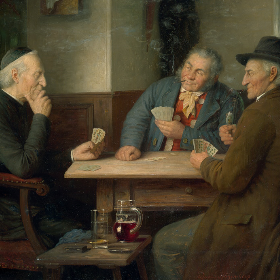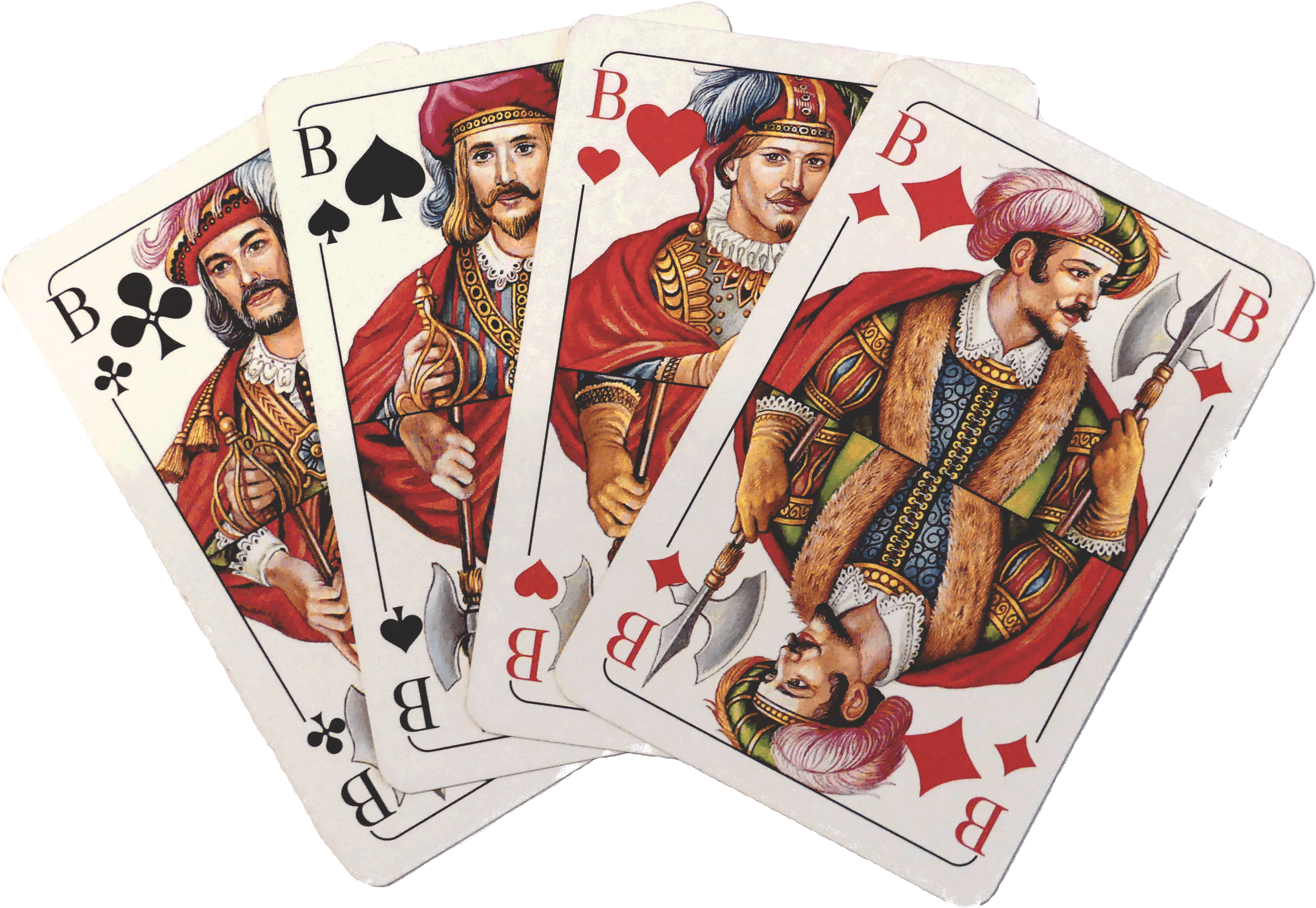Learn the traditional rules of the card game Skat, derived from Germany and popular throughout Canada.
Skat is a card game that’s been around for just over two centuries now, dating back to Germany circa 1810. It’s a fun trick-catching card game for 3 players with unique scoring and interesting card ranking rules that make it more complex than most of its trump-based cousins.
The official organisation for the game in Germany. Information about clubs and tournaments, a shop for Skat equipment, and the official rules. The Pagat Skat page Rules of play and lots more besides International Skat Players Association (US page) The ISPA promotes Skat and organises tournaments in many countries, and runs the world championship. Skat games have an unusual bidding sequence. The first to speak is the Middlehand who, if he/she chooses to bid, announces how many points they think they can win, beginning with 10, and increasing in increments of 2. In reply, the Leader will say “Yes” or “Stay”, meaning he/she can equal or exceed the bid.
North American Skat The following instructions detail the rules for North American Skat and several of it's variants. For the rules for the variant preferred by the German Skat clubs and the ISPA, please see our original Skat game rules. Skat was first and foremost a German game developed in the 1800's and later brought to the Americas by German immigrants wanting a taste of home. Skat games have an unusual bidding sequence. The first to speak is the Middlehand who, if he/she chooses to bid, announces how many points they think they can win, beginning with 10, and increasing in increments of 2. In reply, the Leader will say “Yes” or “Stay”, meaning he/she can equal or exceed the bid. Skat Skat (the A is long, like in 'Ah!' ) is Germany's traditional card game for 3 or 4 players. Combining elements of Bridge, Hearts, Euchre, Pinochle, and Poker many say it is the most exciting card game in the world! Here is what Joseph Wergin in his book on Skat and Sheepshead says about the game.
I’ve chosen to record the rules of this game for two reasons. First of all, it’s a moderately popular game throughout Canada, worthy of inclusion in our ever-growing database. Secondly, I recently finished up a series on the North American game of Scat, which is a completely different card game. Since finishing up that series last week, I’m already being asked to supply the “rules of Skat, with a k”.
So, without further ado… here we go!
How to Play Skat Card Game
Skat Bidding Rules
This game requires exactly 3 players and a 32-card deck of 7s through Aces (remove 2s thru 6s). The rank of cards are a bit unique, so look them over carefully.
J-A-10-K-Q-9-8-7
Notice the Jack is first, followed by Ace, then 10. The cards go in the usual high-to-low order after that.
Their point values, calculated at the end of each hand, are as follows:
Jack = 2
Ace = 11
Ten = 10
King = 4
Queen = 3
9-8-7 = 0

Jacks may not be worth a lot of points, but they have a very special power. All Jacks are trump, all the time. No matter what trump the contractor declares to start a game, the four Jacks will be the highest ranking of all trumps. Also regardless of the trump suit called, Jacks rank highest to lowest in this order:
Jack of Club (J♣) – Jack of Spades (J♠) – Jack of Hearts (J♥) – Jack of Diamonds (J♦)
The next highest ranking Trump is the Ace of the chosen suit, then 10, then K, Q, 9, 8, 7.
If the winning bidder chooses No Trump, called a Grand, only the Jacks are trumps, ranked in the order shown above.
Dealing the Cards
Each player will be dealt 10 cards, but like many Canadian card games, Skat requires the deal to take place in groups of cards, known as packets, rather than one card at a time. After shuffling, the dealer will pass packets of 3 cards in clockwise fashion to each player. Then, a packet of 2 cards is dealt face down to the center of the table. To finish, a packet of 4 cards is dealt to each player, then a packet of 3 to each.
The two cards in the middle are called the “Skat”.
Bidding for Trump
Starting with the player left of the dealer, each will have an opportunity to bid for trump. Players will bid the number of points they believe they can catch throughout the hand. The lowest possible bid is 18, but the winning bidder must catch at least 61 points to win the hand (depending on the contract chosen).
Bidding will make more sense after you understand how to score hands in Skat. For now, you just need to know that bids continue around the table until one player has made the highest, uncontested bid. The player who bids highest wins the contract.
This player will have the option to look at the Skat, exchanging any two cards from his hand at will, then returning the Skat face-down – or – choose not to look at the Skat, called a “Hand Game”, worth extra score at the end.
After the Skat is settled, the player will declare a contract, choosing trump. There are several contract options:
Trump Suit: To declare clubs, spades, hearts or diamonds as trump. Declarer must win minimum 61 points.
Grand: To declare No Trump, in which case only Jacks are trump. Declarer must catch minimum 61 points.
Null: There are no trumps. Declarer cannot catch any tricks.
Null Ouvert (Open): Declarer must play a Hand Game (no Skat), turn all his cards face up for others to see, and catch no tricks.
After declaring a contract, if the player has not looked at the Skat, and is not bidding null, he may also declare any of the following point multipliers:
Schneider: Announcing the player or defenders will win 90+ points.
Schwarz: Announcing the player will win all tricks.
Ouvert (Open): Announcing the player will win all tricks with their entire hand turned face up.
Playing the Game
Player left of the dealer will always go first, regardless of bids, leading any card to first trick. Other players must follow suit if able. If not, they can play any other card; trump or otherwise. The highest trump played wins the trick. If no trump is played, the highest card of the suit led wins the trick. The player who won the trick will lead to the next trick, and so on, until all tricks are captured.
If a Jack trump is played, no matter what suit the Jack is, it is trump. Therefore players must follow suit by playing trump (Jack or trump suit), if possible.
Scoring a Hand

This is the part that takes the most getting used to. After a game is over, the declarer adds up all points in the tricks he’s captured. If the total is 61 or higher, the declarer wins. If the opponents combined points are 60 or more, the declarer cannot possibly have 61+, therefore he is “set”. If the declarer announced Schneider, they must have 90+ points. If announcing Schwarz, all tricks must be captured.
If the declarer wins the contract, score is taken by multiplying the base value of the bidder’s contract with any multipliers they’ve achieved. If the declarer fails to make their bid, lose 2x the value of the bid.
Base Value of Contracts:
- Diamonds = 9 points
- Hearts = 10 points
- Spades = 11 points
- Clubs = 12 points
- Grand = 24 points
| Multipliers | Skat Game | Hand Game |
| Matadors (with or against) | 1 (each) | 1 (each) |
| Game (always applies) | 1 | 1 |
| Hand Game (played without Skat) | 1 | |
| Schneider (90+ points) | 1 | 1 |
| Announced Schneider | 1 | |
| Schwarz (captured all tricks) | 1 | 1 |
| Announced Schwarz | 1 | |
| Ouvert (Open) | 1 |
All multipliers are added together, then that total is multiplied by the base value. For example, in a Hand Game where the winning bidder declares Spades and Schneider with 3 Matadors, the score would look like this:
Base Value = 11
Multipliers = 6 (3 Matadors, 1 Win Game, 1 Hand Game, 1 Announced Schneider)
Total = 66
Null Scores
Null bids have static values and are unaffected by multipliers, making them the easiest to score. The value for winning or losing a null contract is as follows:
| Contract | Points – Win | Points – Lose |
| Null w/ Skat | 23 | -46 |
| Null Hand (w/o Skat) | 35 | -70 |
| Null Ouvert w/ Skat | 46 | -92 |
| Null Ouvert Hand (w/o Skat) | 59 | -118 |
Matadors
Matadors are the highest trump cards, in sequence. If trump is Diamonds, the Matadors would be:
J♣J♠J♥J♦ A♦ 10♦ K♦ Q♦ 9♦ 8♦ 7♦
To have Matadors “with” you is to have a sequence of them, starting with the highest J♣. If the player holds J♣J♠J♥, but no J♦, he is “with 3” Matadors. Holding J♣ but no J♠ is being “with 1”. If the bidder does not have J♣ or J♠, but has J♥, the highest two Matadors are with someone else, therefore the player is “without 2” Matadors.
Whether the player is “with” or “without” a number of Matadors, their hand will multiply by that many points.
Winning the Game

Skat is not played with a target score to win. Instead, every player should be given the same number of opportunities to deal. Decide if you want a shorter or longer game, and set the number of deals per player proportionately. After all deals, the highest scoring player wins.
Skat Card Game Rules
If you’re playing Skat for money – such as penny or nickel per point – the losing players pay the wining players based on the difference in their scores. For example, let’s say the game is nickle-a-point and the final scores are:
- Player 1 = 125
- Player 2 = 78
- Player 3 = 62
Skat Game Rules
- Player 1 beat Player 3 by 63 points. Player 3 owes Player 1 (63 * 0.05) $3.15.
- Player 1 beat Player 2 by 47 points. Player 2 owes Player 1 (47 * 0.05) $2.35.
- Player 2 beat Player 3 by 16 point. Player 3 owes Player 2 (16 * 0.05) $0.80.
Game Of Skat

Want to learn even more about this fascinating card game? Check out the following links…
Bored ? Try Popular Canadian Card Games Online
American Skat Card Game Rules
Royal Vegas Canada offers a good selection of games: everything from Texas Hold’em, video slots, Omaha, 7 card stud, to Limit Hold’em and blackjack. Safe, and fun.
Skat Board Game
Visit http://RoyalVegas.ca
